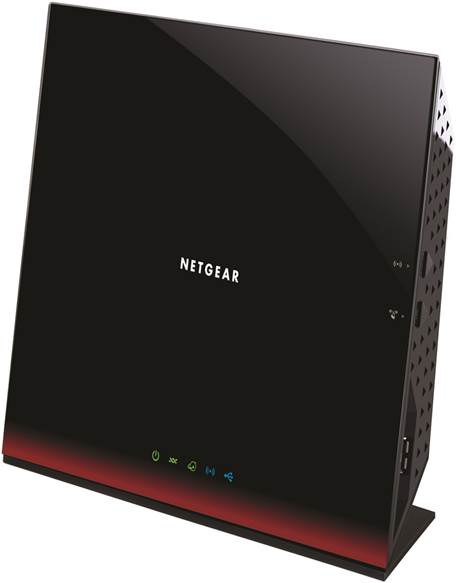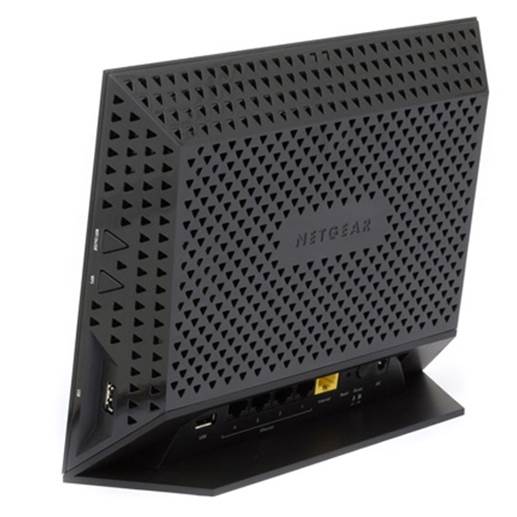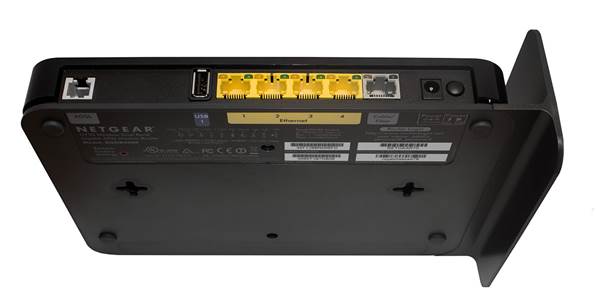Netgear D6300
A seriously fast router and packed
with features, but tarnished by bugs
Netgear’s R6300 was the first 802.11ac
router (web ID: 377218) we tested, and we were impressed with its performance.
The D6300 adds ADSL to the mix, and we’ve now tested the router with its
own-brand 802.11ac USB adapter. When we first tested the R6300, we had to use a
pair of the routers in bridge mode.

Netgear
D6300
The D6300’s maximum nominal throughput over
its 802.11ac 5GHz link is 1,300Mbits/sec, dropping to 300Mbits/sec over 2.4GHz.
Yet, with the $92 Netgear A6200 USB adapter plugged into a free port on our
test laptop, we saw an average speed at close range of 25.1MB/sec. That’s good,
but not as fast as we had expected.
In fact, with the 802.11ac USB adapter it
was a touch slower than the results we saw with our laptop’s integrated 802.11n
Intel Wi-Fi Link 5300 adapter, which peaked at 35MB/sec and averaged at an
impressive 26.6MB/sec.
If we examine the results more closely, we
can see where the problem lies. The speed actually peaks at 31.2MB/sec, which
is around the same speed at which we’d expect a USB 2 external disk drive to
run. It’s no coincidence that the Netgear A6200 USB adapter is a USB 2 device,
too.
If you already have a fast 3x3 Intel
adapter, then, there isn’t any advantage to buying the D6300 for its 802.11ac
capabilities. If you don’t, $352 is an awful lot of cash to fork out when the
equivalent Edimax bundle costs only $240.
The D6300 shouldn’t be discounted, though.
Over 5GHz, it produced the fastest speeds in our long-range test of any router
in the Labs, and it was nippy over 2.4GHz at long range as well. At close range
over 2.4GHz, however, it refused to channel bond, resulting in an average speed
of only 9MB/sec.

Even
without channel-bonded results, the D6300 is the fastest all-round router if
you include its 17.8MB/sec NAS drive test
Even without channel-bonded results, the
D6300 is the fastest all-round router if you include its 17.8MB/sec NAS drive
test. It’s also packed with more useful features than most. However, its
failure to deliver 2.4GHz channel bonding deprives it of an award.
Netgear D6300 specs
Pricing
·
Part code: D6300-100UKS
·
Price : $216
·
Supplier: www.broadbandbuyer.co.uk
·
Dimensions inc antennae (WDH): 255 x 67 x 197mm
·
Warranty: 1 yr RTB
Core specifications
·
Internet connection type: ADSL and cable
·
Dual band (2.4GHz/5GHz): yes
·
Concurrent dual band: yes
·
Wireless standards: 802.11 abgn + ac
·
Maximum throughput (2.4GHz/5GHz):
300/1,300Mbits/sec
·
40MHz channels (2.4GHz/5GHz)
·
Gigabit Ethernet ports: 4
·
10/100 Ethernetports: no
·
USB ports (device support type): 2 (storage,
printer)
·
Security and parental controls
·
Security types: WEP, WPA (personal), WPA2
(personal)
·
Web content filtering: S (via OpenDNS)
·
URL whitelisting: no
·
URL blacklisting: yes
·
Schedule-restricted internet access: yes
·
WPS button/router PIN/device PIN support
Other
·
IPv6 support: yes
·
Wireless repeater functions: yes
·
Wireless on/off switch : yes
·
Power switch: yes
·
User-configurable QoS: yes
·
Media server: yes
·
Torrent server: no
·
Storage format support: FAT16, FAT32, NTFS
·
Guest network: yes
·
Android/iOS app: yes
·
Extendability via apps: no
·
Online firmware updating: yes
Measured average speeds (MB/sec)
·
2.4GHz short range: 9
·
5GHz short range: 26.6
·
802.11ac short range: 25.1
·
2.4GHz long range: 5.8
·
5GHz long range: 4.4
·
USB speed (wired): 17.8
·
ADSL download (wired): 2.1
Netgear DGND4000
A huge range of features, good
future-proofing and quick all-round performance make this router a solid
investment
It takes a fair bit to make a router stand
out, but the Netgear DGND4000 has managed it this month: it’s one of only two
routers on test to support both ADSL and cable connections. This means you can
buy it, safe in the knowledge that if you want to switch from BT or Sky to
Virgin - or vice versa - in the future, you won’t have to dump your router.

Netgear
DGND4000
This isn’t the only area in which the
Netgear excels, though. There’s dual-band concurrent 2.4GHz and 5GHz wireless,
which run at 300Mbits/sec and 450Mbits/sec respectively. There are four Gigabit
Ethernet ports at the rear, a pair of USB 2 sockets for sharing storage or a printer,
and the full range of buttons and switches for power, WPS and wireless
functions.
We also like that the router can be quickly
associated with an OpenDNS account for powerful category-based website
blocking, via a free service Netgear calls Live Parental Controls. Setting it
up is easy: download the management utility from the Netgear website, run
through the wizard, and the router will be associated with an OpenDNS account,
allowing you to block adult-related sites with varying degrees of strictness.
You can even use the online Live Parental
Controls to set up blocks of time and link them with different filter levels,
so that, say, late at night, your network isn’t restricted at all, and during
the day, all adult sites are blocked.
The DGND4000’s web UI isn’t particularly
attractive, but it’s responsive and easy to understand. It provides access to
the broadest array of features of any router in this Labs, along with its
flagship D6300 model. There’s support for wireless repeating, user-configurable
QoS controls, guest networks, and app support for Android and iOS devices. You
can use the mobile apps to manage the router’s various functions, from altering
the wireless channel to setting up parental controls and temporary guest
access, and browse the folder structure of connected USB disks.
Performance isn’t bad, either. At close
range, we recorded average speeds of 17.8MB/sec over 5GHz and 13.8MB/sec over
2.4GHz, results that place the router firmly in the top half of the speed
tables. The router’s 5GHz long-range performance is decent too, maintaining
2.2MB/sec in our demanding file-transfer tests. Long-range 2.4GHz performance
is found wanting, with only the Sky Hub posting a slower speed. Still, USB
transfer speeds were excellent, with an average rate of 14.1MB/sec over a wired
connection, and we found no issues with the router’s ADSL performance.

The
DGND4000’s web UI isn’t particularly attractive
The Netgear DGND4000 has few weaknesses.
Its all-round performance is good, even taking into account that long-range
2.4GHz weak spot, and in terms of features it can’t be beaten.
The only thing that prevents it from
walking off with the overall award is that its main rival - the Asus DSL-N55U
-has better long-range performance at a similar price.
Netgear DGND4000 specs
Pricing
·
Part code: DGND4000-100UKS
·
Price: $128
·
Supplie: www.broadbandbuyer.co.uk
·
Dimensions inc antennae (WDH): 160 x 76 x 159mm
·
Warranty: 1 yr RTB
Core specifications
·
Internet connection type: ADSL and cable
·
Dual band (2.4GHz/5GHz): yes
·
Concurrent dual band : yes
·
Wireless standards: 802.11 abgn
·
Maximum throughput (2.4GHz/5GHz):
300/450Mbits/sec
·
40MHz channels (2.4GHz/5GHz)
·
Gigabit Ethernet ports: 4
·
10/100 Ethernetports: no
·
USB ports (device support type): 2 (storage,
printer)
·
Security and parental controls
·
Security types: WEP, WPA (personal, enterprise),
WPA2 (personal, enterprise)
·
Web content filtering: S (via OpenDNS)
·
URL whitelisting: no
·
URL blacklisting: yes
·
Schedule-restricted internet access: yes
·
WPS button/router PIN/device PIN support
Other
·
IPv6 support: yes
·
Wireless repeater functions: yes
·
Wireless on/off switch: yes
·
Power switch: yes
·
User-configurable QoS: yes
·
Media server: yes
·
Torrent server : no
·
Storage format support: FAT16, FAT32, NTFS
·
Guest network: yes
·
Android/iOS app: yes
·
Extendability via apps : no
·
Online firmware updating: yes
Measured average speeds (MB/sec)
·
2.4GHz short range: 13.8
·
5GHz short range: 17.8
·
802.11ac short range : N/A
·
2.4GHz long range: 1.9
·
5GHz long range: 2.2
·
USB speed (wired): 14.1
·
ADSL download (wired): 2.1